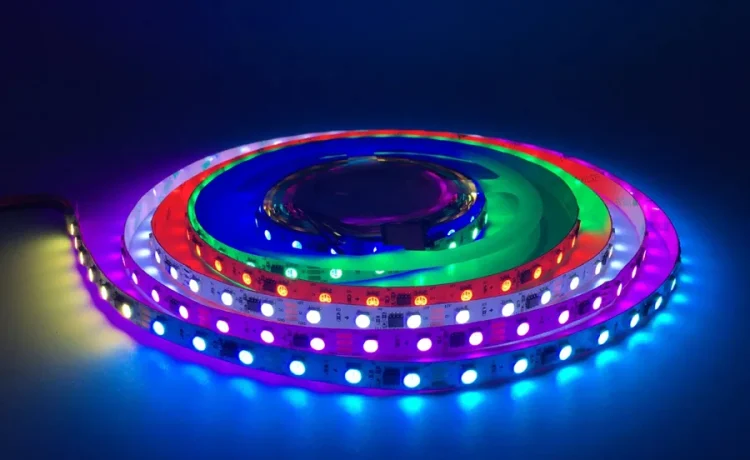In recent years, LED lighting has become a popular choice for both residential and commercial spaces. Its energy efficiency, long lifespan, and versatility make it a smart option for a wide variety of applications. Among the many types of LED lighting available, LED strip lights and LED modules stand out as two of the most adaptable and practical solutions. If you’re considering upgrading or installing LED lighting, understanding these two options can help you make a better choice that fits your needs.
What Are LED Strip Lights?
LED strip lights are flexible circuit boards embedded with small LED bulbs spaced evenly along the length. These strips are often backed with adhesive, making installation straightforward on surfaces like walls, ceilings, or even furniture edges. Their flexibility allows them to bend and curve around corners, which opens up creative possibilities for lighting designs.
People use LED strip lights for accent lighting, under-cabinet lighting in kitchens, backlighting for televisions, or even for decorative effects in events and displays. One of the standout features of LED strip lights is their variety: they come in different color temperatures (from warm white to cool white and RGB color-changing options), brightness levels, and waterproof ratings, which makes them suitable for both indoor and outdoor use.
For those looking for a reliable led strip lights supplier, it’s important to find one offering products that balance quality, versatility, and durability to match specific project requirements.
When choosing LED strip lights, it’s helpful to consider factors such as the type of adhesive, the density of LEDs per meter (which affects brightness and smoothness), and compatibility with dimmers or controllers if you want adjustable lighting effects.
Exploring LED Modules
Unlike strip lights, LED modules are individual LED units encased in small, usually square or rectangular, housings. These modules often come with pre-attached wiring and mounting options, making them ideal for more permanent, fixed installations. LED modules are frequently used for signage, channel letters, or architectural lighting where a more structured and evenly spaced light source is required.
One advantage of LED modules is their durability and consistency. Since they are housed securely, they tend to perform well in outdoor settings and can offer better light distribution for certain applications. Also, LED modules often come in waterproof versions, making them suitable for environments exposed to moisture.
When sourcing LED modules, finding trusted led module suppliers who provide certified and reliable products can ensure better performance and longevity.
Selecting LED modules involves looking at specifications like voltage requirements, beam angles (which determine how the light spreads), and color temperature. The spacing of these modules can also be adjusted to achieve the desired brightness and coverage in a given area.
Factors to Consider When Choosing LED Lighting Components
When deciding between LED strip lights and LED modules, a few key factors should guide your choice. Durability is one — depending on whether the lighting will be indoors or outdoors, waterproofing might be necessary. Power consumption is another important consideration, especially for larger installations where energy efficiency will impact operating costs.
Installation ease can also play a big role. LED strip lights are generally easier to install because of their flexibility and adhesive backing, whereas LED modules might require mounting brackets or screws. However, LED modules can offer more secure and long-lasting setups in places where the lighting needs to stay firmly in place.
Customizability is another factor. LED strip lights often allow for more creative designs and dynamic lighting effects, especially when paired with controllers that change colors or brightness. LED modules, on the other hand, are more suited for uniform lighting and specific applications like signage or task lighting.
Understanding Quality and Standards in LED Lighting
LED lighting products vary widely in quality, and it’s important to pay attention to standards and certifications when choosing components. Reliable LED products usually come with certifications like CE, RoHS, or UL, which indicate they meet safety and environmental standards.
Quality also affects how long your LED lighting will last and how well it maintains brightness over time. Cheaper, lower-quality LEDs might dim quickly or fail sooner, which can be inconvenient and costly to replace.
Choosing LED components from reputable suppliers ensures better performance and peace of mind, especially if you are investing in a large or important lighting project.
How LED Strip Lights and Modules Complement Each Other
In many cases, LED strip lights and LED modules aren’t direct competitors but rather complementary components that can work together to create a more effective lighting solution. For instance, a retail store might use LED strip lights for ambient lighting along shelves and LED modules to illuminate specific signage or display cases with more focused light.
In architectural projects, strip lights can outline edges and highlight shapes, while LED modules can provide consistent illumination for features like facades or channel letters. By combining both, it’s possible to enhance both aesthetics and functionality.
Conclusion:
Choosing the right LED lighting comes down to understanding your specific needs and the environments where the lights will be installed. LED strip lights offer flexibility, creative freedom, and ease of installation, making them ideal for accent and decorative lighting. LED modules provide durability, consistent brightness, and are well suited for signage and architectural lighting.
Both types have their strengths, and in many projects, they work best together to achieve the desired effect. Keeping in mind factors like quality, power consumption, installation requirements, and lighting goals will help you select the best components without unnecessary guesswork.
By approaching LED lighting choices with a clear understanding of these options, you can create spaces that are not only energy-efficient but also visually appealing and suited to your unique needs.


















